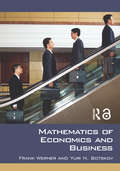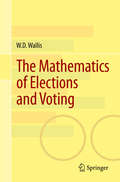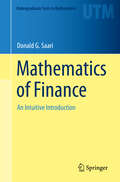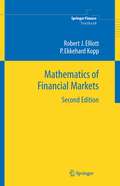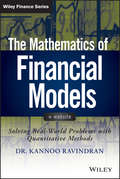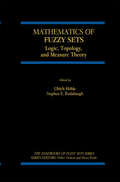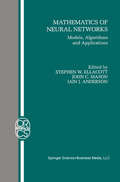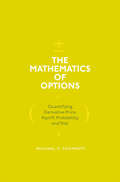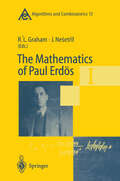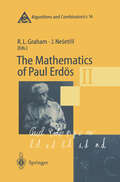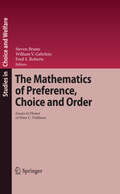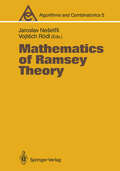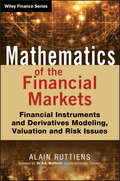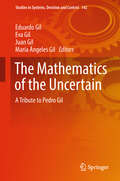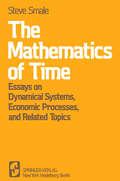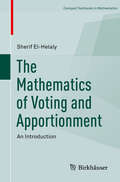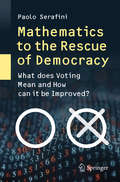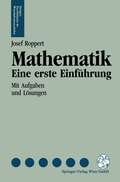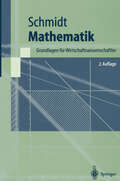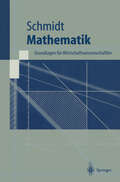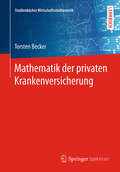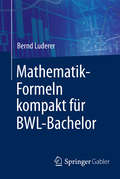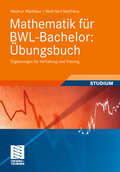- Table View
- List View
Mathematics of Economics and Business
by Frank Werner Yuri N. SotskovFor all students who wish to understand current economic and business literature, knowledge of mathematical methods has become a prerequisite. Clear and concise, with precise definitions and theorems, Werner and Sotskov cover all the major topics required to gain a firm grounding in this subject including sequences, series, applications in finance, functions, differentiations, differentials and difference equations, optimizations with and without constraints, integrations and much more. Containing exercises and worked examples, precise definitions and theorems as well as economic applications, this book provides the reader with a comprehensive understanding of the mathematical models and tools used in both economics and business.
The Mathematics of Elections and Voting
by W.D. WallisThis title takes an in-depth look at the mathematics in the context of voting and electoral systems, with focus on simple ballots, complex elections, fairness, approval voting, ties, fair and unfair voting, and manipulation techniques. The exposition opens with a sketch of the mathematics behind the various methods used in conducting elections. The reader is lead to a comprehensive picture of the theoretical background of mathematics and elections through an analysis of Condorcet’s Principle and Arrow’s Theorem of conditions in electoral fairness. Further detailed discussion of various related topics include: methods of manipulating the outcome of an election, amendments, and voting on small committees.In recent years, electoral theory has been introduced into lower-level mathematics courses, as a way to illustrate the role of mathematics in our everyday life. Few books have studied voting and elections from a more formal mathematical viewpoint. This text will be useful to those who teach lower level courses or special topics courses and aims to inspire students to understand the more advanced mathematics of the topic. The exercises in this text are ideal for upper undergraduate and early graduate students, as well as those with a keen interest in the mathematics behind voting and elections.
Mathematics of Finance: An Intuitive Introduction (Undergraduate Texts in Mathematics)
by Donald G. SaariThis textbook invites the reader to develop a holistic grounding in mathematical finance, where concepts and intuition play as important a role as powerful mathematical tools. Financial interactions are characterized by a vast amount of data and uncertainty; navigating the inherent dangers and hidden opportunities requires a keen understanding of what techniques to apply and when. By exploring the conceptual foundations of options pricing, the author equips readers to choose their tools with a critical eye and adapt to emerging challenges. Introducing the basics of gambles through realistic scenarios, the text goes on to build the core financial techniques of Puts, Calls, hedging, and arbitrage. Chapters on modeling and probability lead into the centerpiece: the Black–Scholes equation. Omitting the mechanics of solving Black–Scholes itself, the presentation instead focuses on an in-depth analysis of its derivation and solutions. Advanced topics that follow include the Greeks, American options, and embellishments. Throughout, the author presents topics in an engaging conversational style. “Intuition breaks” frequently prompt students to set aside mathematical details and think critically about the relevance of tools in context. Mathematics of Finance is ideal for undergraduates from a variety of backgrounds, including mathematics, economics, statistics, data science, and computer science. Students should have experience with the standard calculus sequence, as well as a familiarity with differential equations and probability. No financial expertise is assumed of student or instructor; in fact, the text’s deep connection to mathematical ideas makes it suitable for a math capstone course. A complete set of the author’s lecture videos is available on YouTube, providing a comprehensive supplementary resource for a course or independent study.
Mathematics of Financial Markets (Springer Finance)
by Robert J Elliott P. Ekkehard KoppThis book presents the mathematics that underpins pricing models for derivative securities in modern financial markets, such as options, futures and swaps. This new edition adds substantial material from current areas of active research, such as coherent risk measures with applications to hedging, the arbitrage interval for incomplete discrete-time markets, and risk and return and sensitivity analysis for the Black-Scholes model.
The Mathematics of Financial Models: Solving Real-World Problems with Quantitative Methods (Wiley Finance #658)
by Kannoo RavindranLearn how quantitative models can help fight client problems head-on Before financial problems can be solved, they need to be fully understood. Since in-depth quantitative modeling techniques are a powerful tool to understanding the drivers associated with financial problems, one would need a solid grasp of these techniques before being able to unlock their full potential of the methods used. In The Mathematics of Financial Models, the author presents real world solutions to the everyday problems facing financial professionals. With interactive tools such as spreadsheets for valuation, pricing, and modeling, this resource combines highly mathematical quantitative analysis with useful, practical methodologies to create an essential guide for investment and risk-management professionals facing modeling issues in insurance, derivatives valuation, and pension benefits, among others. In addition to this, this resource also provides the relevant tools like matrices, calculus, statistics and numerical analysis that are used to build the quantitative methods used. Financial analysts, investment professionals, risk-management professionals, and graduate students will find applicable information throughout the book, and gain from the self-study exercises and the refresher course on key mathematical topics. Equipped with tips and information, The Mathematics of Financial Models Provides practical methodologies based on mathematical quantitative analysis to help analysts, investment and risk-management professionals better navigate client issues Contains interactive tools that demonstrate the power of analysis and modeling Helps financial professionals become more familiar with the challenges across a range of industries Includes a mathematics refresher course and plenty of exercises to get readers up to speed The Mathematics of Financial Models is an in-depth guide that helps readers break through common client financial problems and emerge with clearer strategies for solving issues in the future.
The Mathematics of Financial Models: Solving Real-World Problems with Quantitative Methods (Wiley Finance #658)
by Kannoo RavindranLearn how quantitative models can help fight client problems head-on Before financial problems can be solved, they need to be fully understood. Since in-depth quantitative modeling techniques are a powerful tool to understanding the drivers associated with financial problems, one would need a solid grasp of these techniques before being able to unlock their full potential of the methods used. In The Mathematics of Financial Models, the author presents real world solutions to the everyday problems facing financial professionals. With interactive tools such as spreadsheets for valuation, pricing, and modeling, this resource combines highly mathematical quantitative analysis with useful, practical methodologies to create an essential guide for investment and risk-management professionals facing modeling issues in insurance, derivatives valuation, and pension benefits, among others. In addition to this, this resource also provides the relevant tools like matrices, calculus, statistics and numerical analysis that are used to build the quantitative methods used. Financial analysts, investment professionals, risk-management professionals, and graduate students will find applicable information throughout the book, and gain from the self-study exercises and the refresher course on key mathematical topics. Equipped with tips and information, The Mathematics of Financial Models Provides practical methodologies based on mathematical quantitative analysis to help analysts, investment and risk-management professionals better navigate client issues Contains interactive tools that demonstrate the power of analysis and modeling Helps financial professionals become more familiar with the challenges across a range of industries Includes a mathematics refresher course and plenty of exercises to get readers up to speed The Mathematics of Financial Models is an in-depth guide that helps readers break through common client financial problems and emerge with clearer strategies for solving issues in the future.
Mathematics of Fuzzy Sets: Logic, Topology, and Measure Theory (The Handbooks of Fuzzy Sets #3)
by Ulrich Höhle S.E. RodabaughMathematics of Fuzzy Sets: Logic, Topology and Measure Theory is a major attempt to provide much-needed coherence for the mathematics of fuzzy sets. Much of this book is new material required to standardize this mathematics, making this volume a reference tool with broad appeal as well as a platform for future research. Fourteen chapters are organized into three parts: mathematical logic and foundations (Chapters 1-2), general topology (Chapters 3-10), and measure and probability theory (Chapters 11-14). Chapter 1 deals with non-classical logics and their syntactic and semantic foundations. Chapter 2 details the lattice-theoretic foundations of image and preimage powerset operators. Chapters 3 and 4 lay down the axiomatic and categorical foundations of general topology using lattice-valued mappings as a fundamental tool. Chapter 3 focuses on the fixed-basis case, including a convergence theory demonstrating the utility of the underlying axioms. Chapter 4 focuses on the more general variable-basis case, providing a categorical unification of locales, fixed-basis topological spaces, and variable-basis compactifications. Chapter 5 relates lattice-valued topologies to probabilistic topological spaces and fuzzy neighborhood spaces. Chapter 6 investigates the important role of separation axioms in lattice-valued topology from the perspective of space embedding and mapping extension problems, while Chapter 7 examines separation axioms from the perspective of Stone-Cech-compactification and Stone-representation theorems. Chapters 8 and 9 introduce the most important concepts and properties of uniformities, including the covering and entourage approaches and the basic theory of precompact or complete [0,1]-valued uniform spaces. Chapter 10 sets out the algebraic, topological, and uniform structures of the fundamentally important fuzzy real line and fuzzy unit interval. Chapter 11 lays the foundations of generalized measure theory and representation by Markov kernels. Chapter 12 develops the important theory of conditioning operators with applications to measure-free conditioning. Chapter 13 presents elements of pseudo-analysis with applications to the Hamilton&endash;Jacobi equation and optimization problems. Chapter 14 surveys briefly the fundamentals of fuzzy random variables which are [0,1]-valued interpretations of random sets.
Mathematics of Neural Networks: Models, Algorithms and Applications (Operations Research/Computer Science Interfaces Series #8)
by Stephen W. Ellacott John C. Mason Iain J. AndersonThis volume of research papers comprises the proceedings of the first International Conference on Mathematics of Neural Networks and Applications (MANNA), which was held at Lady Margaret Hall, Oxford from July 3rd to 7th, 1995 and attended by 116 people. The meeting was strongly supported and, in addition to a stimulating academic programme, it featured a delightful venue, excellent food and accommo dation, a full social programme and fine weather - all of which made for a very enjoyable week. This was the first meeting with this title and it was run under the auspices of the Universities of Huddersfield and Brighton, with sponsorship from the US Air Force (European Office of Aerospace Research and Development) and the London Math ematical Society. This enabled a very interesting and wide-ranging conference pro gramme to be offered. We sincerely thank all these organisations, USAF-EOARD, LMS, and Universities of Huddersfield and Brighton for their invaluable support. The conference organisers were John Mason (Huddersfield) and Steve Ellacott (Brighton), supported by a programme committee consisting of Nigel Allinson (UMIST), Norman Biggs (London School of Economics), Chris Bishop (Aston), David Lowe (Aston), Patrick Parks (Oxford), John Taylor (King's College, Lon don) and Kevin Warwick (Reading). The local organiser from Huddersfield was Ros Hawkins, who took responsibility for much of the administration with great efficiency and energy. The Lady Margaret Hall organisation was led by their bursar, Jeanette Griffiths, who ensured that the week was very smoothly run.
The Mathematics of Options: Quantifying Derivative Price, Payoff, Probability, and Risk
by Michael C. ThomsettThis book is written for the experienced portfolio manager and professional options traders. It is a practical guide offering how to apply options math in a trading world that demands mathematical measurement. Every options trader deals with an array of calculations: beginners learn to identify risks and opportunities using a short list of strategies, while researchers and academics turn to advanced technical manuals. However, almost no books exist for the experienced portfolio managers and professional options traders who fall between these extremes.Michael C. Thomsett addresses this glaring gap with The Mathematics of Options, a practical guide with actionable tools for the practical application of options math in a world that demands quantification. It serves as a valuable reference for advanced methods of evaluating issues of pricing, payoff, probability, and risk. In his characteristic approachable style, Thomsett simplifies complex hot button issues—such as strategic payoffs, return calculations, and hedging options—that may be mentioned in introductory texts but are often underserved. The result is a comprehensive book that helps traders understand the mathematic concepts of options trading so that they can improve their skills and outcomes.
The Mathematics of Paul Erdös I (Algorithms and Combinatorics #13)
by Ronald Lewis Graham Jaroslav NesetrilIn 1992, when Paul Erdos was awarded a Doctor Honoris Causa by Charles University in Prague, a small conference was held, bringing together a distin guished group of researchers with interests spanning a variety of fields related to Erdos' own work. At that gathering, the idea occurred to several of us that it might be quite appropriate at this point in Erdos' career to solicit a col lection of articles illustrating various aspects of Erdos' mathematical life and work. The response to our solicitation was immediate and overwhelming, and these volumes are the result. Regarding the organization, we found it convenient to arrange the papers into six chapters, each mirroring Erdos' holistic approach to mathematics. Our goal was not merely a (random) collection of papers but rather a thor oughly edited volume composed in large part by articles explicitly solicited to illustrate interesting aspects of Erdos and his life and work. Each chap ter includes an introduction which often presents a sample of related ErdOs' problems "in his own words". All these (sometimes lengthy) introductions were written jointly by editors. We wish to thank the nearly 70 contributors for their outstanding efforts (and their patience). In particular, we are grateful to Bela Bollobas for his extensive documentation of Paul Erdos' early years and mathematical high points (in the first part of this volume); our other authors are acknowledged in their respective chapters. We also want to thank A. Bondy, G. Hahn, I.
The Mathematics of Paul Erdös II (Algorithms and Combinatorics #14)
by Ronald L. Graham Jaroslav NesetrilIn 1992, when Paul Erdos was awarded a Doctor Honoris Causa by Charles University in Prague, a small conference was held, bringing together a distin guished group of researchers with interests spanning a variety of fields related to Erdos' own work. At that gathering, the idea occurred to several of us that it might be quite appropriate at this point in Erdos' career to solicit a col lection of articles illustrating various aspects of Erdos' mathematical life and work. The response to our solicitation was immediate and overwhelming, and these volumes are the result. Regarding the organization, we found it convenient to arrange the papers into six chapters, each mirroring Erdos' holistic approach to mathematics. Our goal was not merely a (random) collection of papers but rather a thor oughly edited volume composed in large part by articles explicitly solicited to illustrate interesting aspects of Erdos and his life and work. Each chap ter includes an introduction which often presents a sample of related Erdos' problems "in his own words". All these (sometimes lengthy) introductions were written jointly by editors. We wish to thank the nearly 70 contributors for their outstanding efforts (and their patience). In particular, we are grateful to Bela Bollobas for his extensive documentation of Paul Erdos' early years and mathematical high points (in the first part of this volume); our other authors are acknowledged in their respective chapters. We also want to thank A. Bondy, G. Hahn, I.
The Mathematics of Preference, Choice and Order: Essays in Honor of Peter C. Fishburn (Studies in Choice and Welfare)
by Steven Brams William V. Gehrlein Fred S. RobertsPeter Fishburn has had a splendidly productive career that led to path-breaking c- tributions in a remarkable variety of areas of research. His contributions have been published in a vast literature, ranging through journals of social choice and welfare, decision theory, operations research, economic theory, political science, mathema- cal psychology, and discrete mathematics. This work was done both on an individual basis and with a very long list of coauthors. The contributions that Fishburn made can roughly be divided into three major topical areas, and contributions to each of these areas are identi?ed by sections of this monograph. Section 1 deals with topics that are included in the general areas of utility, preference, individual choice, subjective probability, and measurement t- ory. Section 2 covers social choice theory, voting models, and social welfare. S- tion 3 deals with more purely mathematical topics that are related to combinatorics, graph theory, and ordered sets. The common theme of Fishburn’s contributions to all of these areas is his ability to bring rigorous mathematical analysis to bear on a wide range of dif?cult problems.
Mathematics of Ramsey Theory (Algorithms and Combinatorics #5)
by Jaroslav Nesetril Vojtech RödlOne of the important areas of contemporary combinatorics is Ramsey theory. Ramsey theory is basically the study of structure preserved under partitions. The general philosophy is reflected by its interdisciplinary character. The ideas of Ramsey theory are shared by logicians, set theorists and combinatorists, and have been successfully applied in other branches of mathematics. The whole subject is quickly developing and has some new and unexpected applications in areas as remote as functional analysis and theoretical computer science. This book is a homogeneous collection of research and survey articles by leading specialists. It surveys recent activity in this diverse subject and brings the reader up to the boundary of present knowledge. It covers virtually all main approaches to the subject and suggests various problems for individual research.
Mathematics of the Financial Markets: Financial Instruments and Derivatives Modelling, Valuation and Risk Issues (The Wiley Finance Series)
by Alain RuttiensThe book aims to prioritise what needs mastering and presents the content in the most understandable, concise and pedagogical way illustrated by real market examples. Given the variety and the complexity of the materials the book covers, the author sorts through a vast array of topics in a subjective way, relying upon more than twenty years of experience as a market practitioner. The book only requires the reader to be knowledgeable in the basics of algebra and statistics. The Mathematical formulae are only fully proven when the proof brings some useful insight. These formulae are translated from algebra into plain English to aid understanding as the vast majority of practitioners involved in the financial markets are not required to compute or calculate prices or sensitivities themselves as they have access to data providers. Thus, the intention of this book is for the practitioner to gain a deeper understanding of these calculations, both for a safety reason – it is better to understand what is behind the data we manipulate – and secondly being able to appreciate the magnitude of the prices we are confronted with and being able to draft a rough calculation, aside of the market data. The author has avoided excessive formalism where possible. Formalism is securing the outputs of research, but may, in other circumstances, burden the understanding by non-mathematicians; an example of this case is in the chapter dedicated to the basis of stochastic calculus. The book is divided into two parts: First, the deterministic world, starting from the yield curve building and related calculations (spot rates, forward rates, discrete versus continuous compounding, etc.), and continuing with spot instruments valuation (short term rates, bonds, currencies and stocks) and forward instruments valuation (forward forex, FRAs and variants, swaps & futures); Second, the probabilistic world, starting with the basis of stochastic calculus and the alternative approach of ARMA to GARCH, and continuing with derivative pricing: options, second generation options, volatility, credit derivatives; This second part is completed by a chapter dedicated to market performance & risk measures, and a chapter widening the scope of quantitative models beyond the Gaussian hypothesis and evidencing the potential troubles linked to derivative pricing models.
Mathematics of the Financial Markets: Financial Instruments and Derivatives Modelling, Valuation and Risk Issues (The Wiley Finance Series)
by Alain RuttiensMathematics of the Financial Markets Financial Instruments and Derivatives Modeling, Valuation and Risk Issues Alain Ruttiens There are many books dedicated to the quantitative finance field but these are either devoted to a specific type of financial instrument, combining both the products description and use in the market and their quantitative aspects, or to a specific mathematical or statistical/econometric theory, or otherwise, with an impressive degree of mathematical formalism which needs a high degree of competence in mathematics, econometrics and quantitative methods. Mathematics of the Financial Markets: Financial Instruments and Derivatives Modeling, Valuation and Risk Issues aims to prioritise what needs mastering and presents the content in the most understandable, concise and pedagogical way illustrated by real market examples. Divided into two parts, the book first examines the deterministic world, starting with yield curve building and related calculations (spot rates, forward rates, discrete versus continuous compounding, etc.), and continuing with spot instruments valuation (short term rates, bonds, currencies and stocks) and forward instruments valuation (forward forex, FRAs and variants, swaps & futures).The second part of the book looks at the probabilistic world, starting with the basis of stochastic calculus and the alternative approach of ARMA to GARCH, and continuing with derivative pricing: options, second generation options, volatility, credit derivatives. This part is completed by a chapter dedicated to market performance & risk measures, and a chapter widening the scope of quantitative models beyond the Gaussian hypothesis and evidencing the potential troubles linked to derivative pricing models. This book equips the reader with the mathematical knowledge needed to explain the valuation and behaviour of financial products, from traditional spot instruments to complex derivatives in the whole set of markets, from currencies and stocks to interest rates and credit underlyings. Written by Alain Ruttiens, an expert author with twenty-five years of practical and academic experience in the financial markets, this book presents the quantitative aspects of financial markets instruments and their derivatives, in a global and coherent way. It is now more crucial than ever to be aware of what is happening, quantitatively speaking, behind the financial instruments behaviour, making this an essential read for anyone concerned with financial markets.
The Mathematics of the Uncertain: A Tribute to Pedro Gil (Studies in Systems, Decision and Control #142)
by Eduardo Gil Eva Gil Juan Gil María Ángeles GilThis book is a tribute to Professor Pedro Gil, who created the Department of Statistics, OR and TM at the University of Oviedo, and a former President of the Spanish Society of Statistics and OR (SEIO). In more than eighty original contributions, it illustrates the extent to which Mathematics can help manage uncertainty, a factor that is inherent to real life. Today it goes without saying that, in order to model experiments and systems and to analyze related outcomes and data, it is necessary to consider formal ideas and develop scientific approaches and techniques for dealing with uncertainty. Mathematics is crucial in this endeavor, as this book demonstrates. As Professor Pedro Gil highlighted twenty years ago, there are several well-known mathematical branches for this purpose, including Mathematics of chance (Probability and Statistics),Mathematics of communication (Information Theory), andMathematics of imprecision (Fuzzy Sets Theory and others).These branches often intertwine, since different sources of uncertainty can coexist, and they are not exhaustive. While most of the papers presented here address the three aforementioned fields, some hail from other Mathematical disciplines such as Operations Research; others, in turn, put the spotlight on real-world studies and applications. The intended audience of this book is mainly statisticians, mathematicians and computer scientists, but practitioners in these areas will certainly also find the book a very interesting read.
The Mathematics of Time: Essays on Dynamical Systems, Economic Processes, and Related Topics
by Steve SmaleThe Mathematics of Voting and Apportionment: An Introduction (Compact Textbooks in Mathematics)
by Sherif El-HelalyThis textbook contains a rigorous exposition of the mathematical foundations of two of the most important topics in politics and economics: voting and apportionment, at the level of upper undergraduate and beginning graduate students. It stands out among comparable books by providing, in one volume, an extensive and mathematically rigorous treatment of these two topics.The text’s three chapters cover social choice, yes-no voting, and apportionment, respectively, and can be covered in any order, allowing teachers ample flexibility. Each chapter begins with an elementary introduction and several examples to motivate the concepts and to gradually lead to more advanced material. Landmark theorems are presented with detailed and streamlined proofs; those requiring more complex proofs, such as Arrow’s theorems on dictatorship, Gibbard’s theorem on oligarchy, and Gärdenfors’ theorem on manipulation, are broken down into propositions and lemmas in order to make them easier to grasp. Simple and intuitive notations are emphasized over non-standard, overly complicated symbols. Additionally, each chapter ends with exercises that vary from computational to “prove or disprove” types.The Mathematics of Voting and Apportionment will be particularly well-suited for a course in the mathematics of voting and apportionment for upper-level undergraduate and beginning graduate students in economics, political science, or philosophy, or for an elective course for math majors. In addition, this book will be a suitable read for to any curious mathematician looking for an exposition to these unpublicized mathematical applications.No political science prerequisites are needed. Mathematical prerequisites (included in the book) are minimal: elementary concepts in combinatorics, graph theory, order relations, and the harmonic and geometric means. What is needed most is the level of maturity that enables the student to think logically, derive results from axioms and hypotheses, and intuitively grasp logical notions such as “contrapositive” and “counterexample.”
Mathematics to the Rescue of Democracy: What does Voting Mean and How can it be Improved?
by Paolo SerafiniThis book explains, in a straightforward way, the foundations upon which electoral techniques are based in order to shed new light on what we actually do when we vote. The intention is to highlight the fact that no matter how an electoral system has been designed, and regardless of the intentions of those who devised the system, there will be goals that are impossible to achieve but also opportunities for improving the situation in an informed way. While detailed descriptions of electoral systems are not provided, many references are made to current or past situations, both as examples and to underline particular problems and shortcomings. In addition, a new voting method that avoids the many paradoxes of voting theory is described in detail. While some knowledge of mathematics is required in order to gain the most from the book, every effort has been made to ensure that the subject matter is easily accessible for non-mathematicians, too. In short, this is a book for anyone who wants to understand the meaning of voting.
Mathematik: Eine erste Einführung (Springers Kurzlehrbücher der Wirtschaftswissenschaften)
by Josef RoppertDas Buch erleichtert dem Studienanfänger die Einstellung auf die Anforderungen an der Hochschule durch eine breite und eingehende Darstellung. Auf Schulkenntnissen aufbauend, bringt es den Stoff einer einführenden mathematischen Universitätsvorlesung, wobei das Schwergewicht auf dem Verständnis der Inhalte liegt.
Mathematik: Grundlagen für Wirtschaftswissenschaftler (Springer-Lehrbuch)
by Klaus D. SchmidtMathematische Modelle und Methoden sind in weiten Teilen der Wirtschaftswissenschaften unverzichtbar; dabei dient die Mathematik einerseits als Sprache zur Modellierung komplexer wirtschaftlicher Zusammenhänge, andererseits als Werkzeug zur Analyse wirtschaftswissenschaftlicher Modelle. Dieses Buch behandelt die wichtigsten Aspekte der Linearen Algebra und der Analysis. Schwerpunkte sind lineare Gleichungssysteme, lineare Differenzen- und Differentialgleichungen sowie lineare und nichtlineare Optimierungsprobleme unter Nebenbedingungen. Die dargestellten Konzepte werden anhand zahlreicher Beispiele verdeutlicht.
Mathematik: Grundlagen für Wirtschaftswissenschaftler (Springer-Lehrbuch)
by Klaus D. SchmidtMathematische Modelle und Methoden sind in weiten Teilen der Wirtschaftswissenschaften unverzichtbar; dabei dient die Mathematik einerseits als Sprache zur Modellierung komplexer wirtschaftlicher Zusammenhänge, andererseits als Werkzeug zur Analyse wirtschaftswissenschaftlicher Modelle. Dieses Buch behandelt die wichtigsten Aspekte der Linearen Algebra und der Analysis. Schwerpunkte sind lineare Gleichungssysteme, lineare Differenzen- und Differentialgleichungen sowie lineare und nichtlineare Optimierungsprobleme unter Nebenbedingungen. Die dargestellten Konzepte werden anhand zahlreicher Beispiele verdeutlicht.
Mathematik der privaten Krankenversicherung (Studienbücher Wirtschaftsmathematik)
by Torsten BeckerDas vorliegende Buch ist eine grundlegende Einführung in die mathematischen Methoden der deutschen privaten Krankenversicherung. Im Fokus stehen die Themen Rechnungsgrundlagen, Prämienberechnung und Alterungsrückstellung. Dabei werden insbesondere auch wichtige Entwicklungen der letzten Jahre wie Portabilität der Alterungsrückstellung oder Unisextarifierung dargestellt. Obwohl die Anwendung der Ergebnisse im Vordergrund steht, wird Wert auf eine angemessene mathematische Fundiertheit gelegt. Viele praktische Beispiele sowie Aufgaben mit Lösungshinweisen machen das Buch zu einem hilfreichen Begleiter in Studium, Aktuarausbildung und Beruf.
Mathematik-Formeln kompakt für BWL-Bachelor
by Bernd LudererDiese Formelsammlung wendet sich an Bachelor-Studierende der Wirtschafts- und Sozialwissenschaften an Universitäten, Fachhochschulen, Berufsakademien und Weiterbildungseinrichtungen, aber auch an Praktiker. Sie dient dem schnellen Nachschlagen von Formeln, Begriffen und Algorithmen, sei es im Studium oder Selbststudium, beim Lösen konkreter Aufgaben oder in der Prüfung. In übersichtlicher und klar strukturierter Weise wurden nur die allerwichtigsten, unverzichtbaren Formeln und Fakten aufgenommen, diese dafür wo immer möglich erläutert. Auch auf ökonomische Anwendungen wurde großer Wert gelegt.Die enthaltenen Teilgebiete der (Wirtschafts-)Mathematik sind: Mengen und Aussagen, Rechnen mit Zahlen, Zahlenfolgen und -reihen, Kombinatorik, klassische Finanzmathematik, Differenzial- und Integralrechnung für Funktionen einer Veränderlichen, Differenzialrechnung für Funktionen mehrerer Veränderlicher, lineare Algebra und lineare Optimierung. Ein umfangreiches Sachwortverzeichnis erleichtert das schnelle Auffinden von Formeln und Fakten.
Mathematik für BWL-Bachelor: Ergänzungen für Vertiefung und Training (Studienbücher Wirtschaftsmathematik)
by Heidrun Matthäus Wolf-Gert MatthäusDieses Buch stellt die ideale Ergänzung zum Lehrbuch „Mathematik für BWL-Bachelor“ dar. Es enthält mehr als 200 sorgsam zusammengestellte Übungsaufgaben mit ansteigender Schwierigkeit sowie ausführliche Lösungen. Einleitend werden zu jedem Themenkomplex des Lehrbuches typische Musteraufgaben vorgerechnet, denen verwandte Aufgaben folgen. Nach der Beschäftigung mit formal-mathematischen Aufgaben erfolgt anschließend die behutsame Heranführung an Anwendungen in der Betriebswirtschaftslehre.
